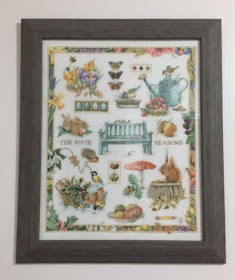For several years, at this time of year, Skip and I have travelled to NY state for a bit of a holiday. This year we decided to explore the lower area of central NY state, specifically Corning.
We really enjoy not having to drive through Toronto to get there. Instead we head eastward from where we live east of The Big City and cross into the US near the Ivy Lea parkway, Wellesley Island, and Alexandria Bay.
The last time I had visited Corning was about 20 years ago. It was as cute as I remembered. Skip and I enjoyed Mexican food, shopping, the museum, free shuttle bus, and lovely weather.
Here are some of the highlights of the museum:
This blown glass sculpture (2000) by Dale Chihuly is at the entrance where one obtains the tickets. I loved that it was my favourite colour.
Italian artist, Lino Tagliapietra created 18 gondola-like boats influenced by his Venetian roots.
Inspired by a sketchbook page by Albrecht Durer,
Maria Klonowska of Dusseldorf, Germany created this lynx.
Still Life with Two Plums was created in 2000 by American artists Flora C. Mace and Joey Kirkpatrick. The pieces are blown glass in a carved and painted alderwood bowl.
This photo gives you an idea of the size of it.
 |
| Photo Brandy Harold - Craft Council |
This is entitled Continuous Mile (2006 - 2008) and was created by American artist, Liza Lou. It is a 'monumental sculpture' consisting of 4.5 million glossy, black glass beads woven onto a mile-long cotton rope that is coiled and stacked. The sculpture stands 3 feet high and nearly 5 feet in diamater. It took two years to make with a team of beadworkers from several townships in South Africa.
I liked this glass eggplant - or was is a plum?
A glass blower.
These are Italian glass pieces from the 19th Century.
This was a small pendant.
This is a micromosaic rendering of the Basilica of San Marco in Venice.
 |
| Photo Corning Museum of Glass website |
These minute glass tiles create beautiful, textured pictures.
The detail is impressive. Here, the winged lion, the symbol of the city of Venice, is easily seen.
The tiles are about the length of a short fingernail tip and about half the width.
This portrait is also a mosaic.
We had a nice, Mexican lunch downtown, having ridden the free shuttlebus from where we parked the car for free at the museum.
I explored the local yarn shop,
Wooly Minded, but didn't find anything 'to die for' and left empty-handed.
The next day, after doing some shopping in the Elmira/Horseheads area, we made our way to Auburn, NY, through wine country between Seneca Lake and Cayuga lake and through Seneca Falls. We spent the next morning in Skaneateles, walking around the downtown and poking around the cute shops. In the Irish shop, I found a pendant of a St. Brigid's cross.
It is a 2 year late souvenir of our time spent on the Aran isle of Inisheer when we were on our Irish knitting tour in 2013. This is the St. Brigid's cross I made out of reed in our workshop lead by
Mairéad Sharry.
While in Auburn, we did more shopping including the local yarn shop,
All Tied Up Yarns, and I came away with a skein of Madelinetosh Merino Light in the Jade colourway.
I may use it to knit Susan Ashcroft's
Hogwarts Express shawl.
The next day headed for home after breakfast. We celebrated Canada Day in the US and today are home for Independence Day. One of these years, we'll have to plan to be in the US on July 4 and find a town whose band plays an outdoor gazebo concert like we experienced about 10 years ago in Skaneateles.



































































